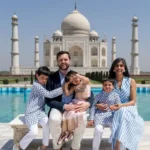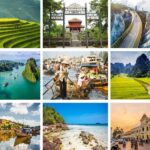Table of Contents
Introduction: Why Vietnam Captivates the World
Vietnam is a captivating country in Southeast Asia, known for its breathtaking landscapes, rich cultural traditions, dynamic cities, and resilient history. From the misty mountains of the north to the bustling Mekong Delta in the south, Vietnam offers visitors an unforgettable journey.
This comprehensive guide explores:
Vietnam’s history
Its vibrant culture
Tourist attractions
The economy
Travel tips and FAQs
Let’s dive into what makes Vietnam an unforgettable destination and a fascinating study of resilience and progress.
History of Vietnam: A Journey Through Time
Ancient Origins
Vietnam’s history stretches back thousands of years.
Archaeological findings in Dong Son show a thriving Bronze Age civilization (~1000 BCE).
The ancient Van Lang and Au Lac kingdoms were among the earliest organized societies.
Chinese Domination and Independence
For nearly a millennium (111 BCE–938 CE), Vietnam was under Chinese rule.
In 938 CE, Ngo Quyen defeated the Chinese at the Battle of Bach Dang River, marking independence.
The next 900 years saw the rise of powerful dynasties like the Ly, Tran, and Le.
French Colonization
In the mid-19th century, France colonized Vietnam as part of French Indochina.
French rule introduced modern infrastructure but also economic exploitation and cultural suppression.
The Vietnam War
After defeating the French at Dien Bien Phu in 1954, Vietnam split into North and South.
The US-backed South Vietnam fought the communist North in a devastating war (1955–1975).
The war ended in 1975 with the fall of Saigon (now Ho Chi Minh City) and national reunification.
Post-war to Modern Era
Economic reforms known as Đổi Mới (Renovation) began in 1986, transforming Vietnam into a fast-growing economy.
Today, Vietnam is a socialist republic and one of the most dynamic economies in Asia.
Vietnam’s Vibrant Culture
Ethnic Diversity
Home to 54 ethnic groups, with the Kinh (Viet) making up ~85%.
Other groups like Tay, Thai, Hmong, and Khmer add cultural richness.
Language and Religion
Vietnamese is the official language.
Major religions: Buddhism, Catholicism, Confucianism, Taoism, and traditional animist beliefs.
Festivals and Traditions
Tet (Lunar New Year): The biggest holiday, celebrating family and ancestors.
Mid-Autumn Festival: Lanterns, mooncakes, and children’s festivities.
Water puppet shows and folk music reflect Vietnam’s artistic heritage.
Vietnamese Cuisine
Famous for fresh ingredients, balance of flavors, and healthiness.
Must-try dishes:
Pho: Noodle soup with beef or chicken.
Banh Mi: French-inspired sandwich with Vietnamese fillings.
Goi Cuon: Fresh spring rolls.
Bun Cha: Grilled pork with noodles.
Tourism in Vietnam: Best Places to Visit
Vietnam has something for everyone—beaches, mountains, historic cities, and cultural experiences. Here are some must-see destinations:
1. Hanoi
Vietnam’s capital combines colonial charm with bustling street life.
Highlights:
Hoan Kiem Lake
Old Quarter
Ho Chi Minh Mausoleum
2. Ha Long Bay
UNESCO World Heritage site with thousands of limestone islands.
Popular for cruises, kayaking, and photography.
3. Sapa and the Northern Highlands
Known for terraced rice fields, colorful ethnic markets, and hiking.
4. Hue
Ancient capital with imperial palaces, pagodas, and royal tombs.
5. Hoi An
Beautifully preserved ancient town with lantern-lit streets and tailor shops.
6. Da Nang
Gateway to beaches, Marble Mountains, and the Golden Bridge.
7. Ho Chi Minh City
Former Saigon is Vietnam’s largest city and economic hub.
Don’t miss:
War Remnants Museum
Ben Thanh Market
Notre Dame Cathedral
8. Mekong Delta
Explore river life, floating markets, and lush canals.
9. Phu Quoc Island
Idyllic beaches, coral reefs, and luxury resorts.
Vietnam’s Economy: From Struggle to Success
Agriculture to Industry
Historically agricultural (rice, coffee, seafood).
Post-Đổi Mới reforms led to industrialization and global integration.
Key Industries
Textiles and garments
Electronics manufacturing
Tourism
Seafood and agriculture exports
Economic Growth
One of the world’s fastest-growing economies (~6–7% GDP growth).
Member of ASEAN, WTO, and several free trade agreements.
Investment Destination
Attractive for foreign investors due to young workforce, low costs, and strategic location.
Travel Tips for Visiting Vietnam
Best Time to Visit
North: October–April (cool, dry season)
Central: February–August
South: December–April
Visa Information
Many nationalities can enter visa-free for 15–30 days.
E-visas available for others.
Currency
Vietnamese Dong (VND).
Cash is widely used; credit cards accepted in major cities.
Getting Around
Domestic flights are affordable.
Trains and buses connect major destinations.
Motorbikes are popular but can be chaotic!
Safety and Etiquette
Generally safe for travelers.
Dress modestly when visiting temples.
Remove shoes before entering homes or sacred spaces.
Why Visit Vietnam?
Unique Experiences
Cruise on Ha Long Bay
Trekking in Sapa
Street food tours in Hanoi and Ho Chi Minh City
Experiencing Tet celebrations
Affordable Destination
Vietnam is one of Southeast Asia’s most budget-friendly countries.
Warm Hospitality
Known for its welcoming people and vibrant communities.
Vietnam by the Numbers
| Statistic | Value |
|---|---|
| Population (2025 est.) | ~100 million |
| Official Language | Vietnamese |
| Capital | Hanoi |
| Largest City | Ho Chi Minh City |
| Currency | Vietnamese Dong (VND) |
| GDP (2024 est.) | ~$450 billion |
| Main Exports | Electronics, textiles, seafood, coffee |
FAQs About Vietnam
Q1: Is Vietnam safe for tourists?
Yes, Vietnam is generally safe, with low violent crime. Be cautious with traffic and petty theft in busy areas.
Q2: Do I need a visa to visit Vietnam?
Many countries get visa-free entry for 15–30 days; others can apply online for an e-visa.
Q3: What’s the best month to visit Vietnam?
October to April is ideal for most regions due to cooler, drier weather.
Q4: How much does a trip to Vietnam cost?
Budget travelers can get by on ~$30/day, while luxury travelers might spend $200+/day.
Q5: What should I pack for Vietnam?
Lightweight clothes, rain jacket, comfortable shoes, sun protection, and insect repellent.
Q6: Can I drink tap water in Vietnam?
No—stick to bottled or filtered water.
Q7: What are some must-try foods?
Pho, banh mi, bun cha, fresh spring rolls, and Vietnamese coffee.
Q8: Is English widely spoken?
English is spoken in tourist areas but less so in rural regions. Learning a few Vietnamese phrases helps.
Q9: What currency is used?
The Vietnamese Dong (VND).
Q10: Are there any cultural taboos?
Don’t point feet at people, touch heads, or raise your voice in anger.
Summary Table
| Aspect | Highlights |
|---|---|
| History | Ancient kingdoms, Chinese & French rule, Vietnam War, Đổi Mới reforms |
| Culture | 54 ethnic groups, festivals, unique cuisine |
| Tourism | Hanoi, Ha Long Bay, Sapa, Hue, Hoi An, beaches |
| Economy | Fast-growing, diverse industries |
| Travel Tips | Best time: Oct–Apr; visa: often required; currency: VND |
| Why Visit? | Culture, food, affordability, natural beauty |
Conclusion
Vietnam is a land of contrasts—ancient yet modern, serene yet bustling. Its resilient history, vibrant culture, scenic beauty, and economic dynamism make it a must-visit destination and an inspiring story of progress.
Whether you’re a traveler seeking adventure, a foodie exploring flavors, or a history buff fascinated by centuries of resilience, Vietnam welcomes you with open arms and endless wonders.
Plan your trip, savor the experiences, and let Vietnam leave a lasting impression on your heart.











